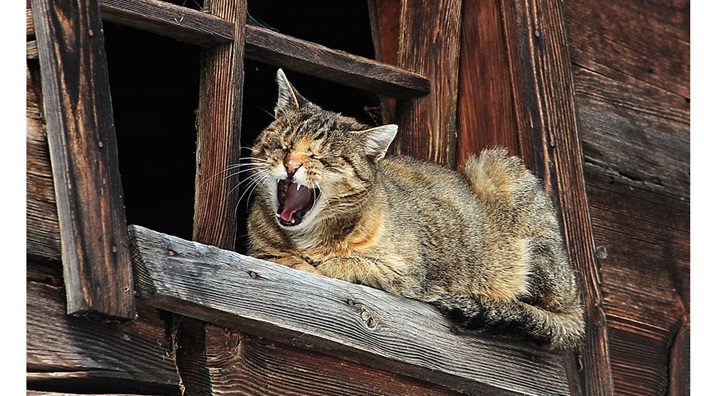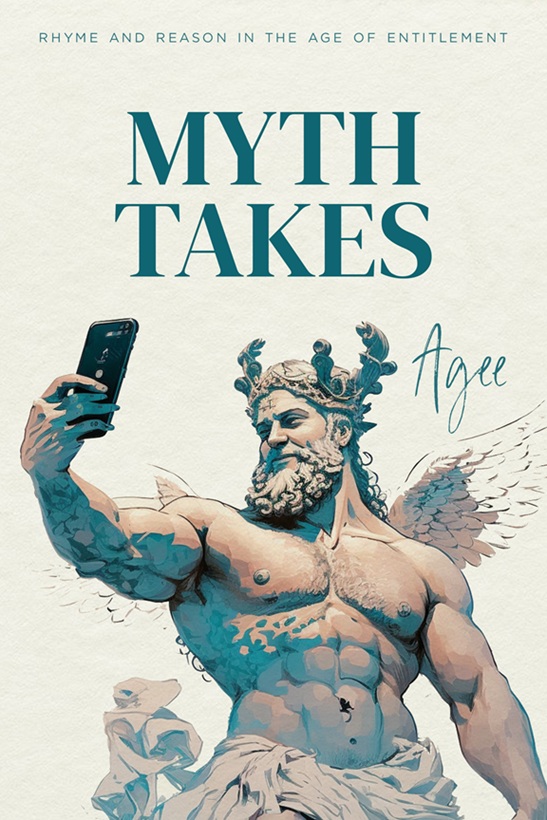.
Cat Contentment
The cat begins his yawn by curling out
His pinkest tongue tip as his lips begin
To part. His faith in comfort is devout.
Disturbing his furred sleepiness is sin.
At least that seems to be the message of
His silent tongue which furls up towards God.
This cat despises all that is not love
Of he himself. To him all else is odd
In all religions. He wants Sabbath rest
All seven days and seven nights. His yawn
Distracts us from his whiskers that are blessed
With curving also. Then his tongue’s withdrawn.
_He settles back to sleep on lap and thigh.
__He lets his nose release a comfy sigh.
.
.
Phillip Whidden is an American living in England who has been published in America, England, Scotland (and elsewhere) in book form, online, and in journals.















The feline captured to purr-fection.
Nicely done, Phillip.
Thanks for such a pawzitive reaction, Paul Freeman.
I love this lighthearted poem, especially, “This cat despises all that is not love / Of he himself.” “He wants sabbath rest / All seven days and seven nights.” perfectly describes the personality and egocentric yet funny nature of cats. It really made me smile!
Thank you, Cynthia Erlandson. I hope I didn’t cause you a near coronary event by being light-hearted and attempting to be funny. No. You seem to have smiled instead. Cue: happy face symbol.
By the way, Cynthia Erlandson, the pic pasted in by the Society seems to be a female cat despite the fairly clear internal indications in the sonnet that it is a male (or neutered male) cat. Oh, well. Maybe this set of facts is just a test to see if we are paying attention.
A simple and light cat poem is enough to make my day. The tongue rolling out towards God is a clever way to describe its length. What’s so special about this poem is that it highlights some of the main traits that distinguish these fur bags from others. Like Cynthia, I too like those lines, especially.
Shamik Banerjee, thank you. As you must have figured out previously, “simple and light” are not what I usually aim for in my sonnets, but we all stray from our ordinary routines occasionally. I love that tongue curl in a cat’s yawn. I’m glad the poem pleased you. I note that you and Cynthia like particular lines.
Maybe that implies that that makes them distinguished. Today I’ve written a sonnet attacking those who rebel against the liberating constraints of traditional poetry and art, liberating writers from dribbled out poetry.
A pleasantly ditty. You’ve captured cattitude well.
Yes, Daniel Kemper. I’m unconvinced that it is an actual poem. It is not ambivalent enough to be proper poetry. It pleases. It’s a ditty. I really like your word play. “Purred play” comes to mind.
A good description is proper poetry, Phillip. Especially when it includes interpretation of what is described. Here we see not only an animal, but motion in which he displays purrsonality. Well done.
Margaret Coats, thank you. Yes, description is a big part of serious poetry. Proper poetry is often expected to go beyond description. Perhaps, for instance, Western poetry is expected to enter into realms of thinking and feeling in such a way as to be wider than description of the particularities of an intensely described instance. This specific sonnet meets that sort of “requirement” by dragging in “God” and “sin,” for example. The sonnet opens out beyond the complacent cat, and, indeed, opens up more about God and sin by bringing into the text ideas clustered around God and sin, such as being “devout” and Sabbath keeping (albeit ironically through Horation satire). The first sentence restricts itself to very focused capturing of physical facts. The sonnet returns near its end (its last three sentences), in a sort of aria da capo, to very focused physical images (though “comfy” is an intrusively imposed interpretation of a fact). Now no poet can usually do much more than aim to create a poem that is proper poetry from the first words onward to the final period. In fact a poet is probably happy enough if somewhere in the mix there is a stand out moment of intensity, memorable intensity, such as a “my favorite image or line is . . .” blink. I feel that this sonnet did a dependable job of description and went beyond desciption occasionally.
For me description is more than a poem should aim for more, “The desire of the moth for the star.” I think that the ratio between high-end content and good description should be weighted more toward the former. This can be accomplished very simply by introducing death into the description as in Sarah Henderson Hay’s “For a Dead Kitten”.
Sorry, I keyed in incorrectly. “For me description is more than a poem” should read, “For me description should be more and a poem…”
A while ago on this site, an epigraph of a poem I wrote stated that every poet should write at least one cat poem. This is yours, and, dammit, man, you know your cats.
Well, C. B. Anderson, dammit–that was good of you. I’ve had about 65 years to get to know these critters in various parts of the world, so I’d be ashamed if I hadn’t learned a bit about catdom. For the record, I’ve written more than one cat poem. Supposedly (SUPPOSEDLY) the search option on my website will take you to more of them: http://www.phillipwhidden.com . The cat I loved most I named Kipper. What you eat you are.
Phillip, I love this beautifully crafted sonnet with its heavenly message. I particularly like the way the words fit and trip off the tip of the tongue to fall from the lips with ease… I love your deft employment of assonance, and I especially like those subtle internal rhymes that lift the poem to harmonious heights. I am under the spell of an elderly feline, and I recognize him in your words. Thank you!
Well now, Susan Jarvis Bryant, a writer could hardly hope for more happy praise than that–or from someone as knowledgeable and careful a reader as you are of a rhymed and rhythmic piece. Thank you very much. I think Prospero might well love to meet you. I’m sure he would feel you are magic. Today I wrote yet another “cat sonnet,” this time harking back to Bastet and ancient Egyptian astral matters…though I feel uncomfortable about calling it a “cat sonnet”–since it is about even more than that supersized subject, cats.